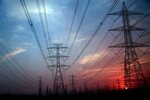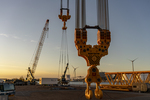News Release from Global Wind Energy Council
Wind Industry Profile of
04/02/2011
Africa - Waterless generation of energy makes wind power a likely energy source for the continent's future
Wind energy could bring many benefits to Africa due to its scalability, which means that it can play a key role in both decentralized and centralized systems. Also, the fact that wind power uses no water to generate electricity is good news for this water-stressed continent.
About a quarter of the world’s population has no access to electricity, and the problem is especially acute in peri-urban and rural areas in Sub-Saharan Africa. In many African countries, the electricity that is available is likely to be generated from diesel generators or other small-scale plant.
These very often use expensive imported fuel and many countries spend a considerable share of their scarce foreign exchange reserves on energy imports. Large-scale power production in Africa, where it exists, is mostly by large hydro (as found in Egypt) or coal-based generation (as in South Africa).
Africa’s wind resource is best around the coasts and in the eastern highlands, but it is only in Mediterranean North Africa that wind power has been developed at scale. 97% of the continent’s total wind farm installations are located in Egypt (550 MW), Morocco (286 MW) and Tunisia (114 MW).
Egypt has a target of producing 20% of its electric power from renewable sources by 2020, and this includes a 12% contribution from wind turbines, which translates into more than 7,200 MW of grid-connected wind power. Most of Egypt’s wind development to date is in the Zafarana district on the Red Sea coast, but there are also plans to construct a 250 MW wind farm at Gabal el-Zeit, and a recent tender has called for proposals to build a further 500 MW wind farm in the Gulf of Suez. A second tender for the same amount is expected for July 2011.
Morocco has excellent wind resources along the coastline, as well as inland near the Atlas Mountains. The Moroccan government has set a target of raising the contribution of renewable energy to 20% of national electricity consumption (up from 7.9%) by 2020.
Wind power is poised to play a key role with a targeted 2,000 MW of capacity, up from the existing 286 MW at the end of 2010. Half of wind turbines will be installed by the government owned utility ONE, with the other half coming from industrial players producing their own wind power.
South Africa’s electricity system, which is primarily based on coal, suffers from low reserve margins, and is barely adequate to meet demand. The state utility Eskom estimates that the country needs to construct 40 GW of new generating capacity by 2025. South Africa is ideally suited for wind power development, given its abundant wind resources.
While currently only one commercial-scale wind farm is in operation, the 8 MW Darling wind farm, the South African Wind Energy Association (SAWEA) estimates that with the right policy framework, wind turbines could provide as much as 20% of the country’s energy demand by 2025, translating into 30,000 MW of installed wind farm capacity.
According to SAWEA, 7,000 MW of this wind farm capacity is already at various stages of development, waiting for confirmation of grid connection and a Power Purchase Agreement (PPA).
Interestingly there have recently been developments in East Africa, with a 300 MW wind farm project under construction in Kenya and other wind turbines projects well advanced in Ethiopia and Tanzania. These early projects will make a substantial contribution to the total generating capacity in each of these countries and may spur similar large scale developments in other African countries.
For more information on this article or if you would like to know more about what www.windfair.net can offer, please do not hesitate to contact Trevor Sievert at ts@windfair.net
www.windfair.net is the largest international B2B Internet platform – ultimately designed for connecting wind energy enthusiasts and companies across the globe!
About a quarter of the world’s population has no access to electricity, and the problem is especially acute in peri-urban and rural areas in Sub-Saharan Africa. In many African countries, the electricity that is available is likely to be generated from diesel generators or other small-scale plant.
These very often use expensive imported fuel and many countries spend a considerable share of their scarce foreign exchange reserves on energy imports. Large-scale power production in Africa, where it exists, is mostly by large hydro (as found in Egypt) or coal-based generation (as in South Africa).
Africa’s wind resource is best around the coasts and in the eastern highlands, but it is only in Mediterranean North Africa that wind power has been developed at scale. 97% of the continent’s total wind farm installations are located in Egypt (550 MW), Morocco (286 MW) and Tunisia (114 MW).
Egypt has a target of producing 20% of its electric power from renewable sources by 2020, and this includes a 12% contribution from wind turbines, which translates into more than 7,200 MW of grid-connected wind power. Most of Egypt’s wind development to date is in the Zafarana district on the Red Sea coast, but there are also plans to construct a 250 MW wind farm at Gabal el-Zeit, and a recent tender has called for proposals to build a further 500 MW wind farm in the Gulf of Suez. A second tender for the same amount is expected for July 2011.
Morocco has excellent wind resources along the coastline, as well as inland near the Atlas Mountains. The Moroccan government has set a target of raising the contribution of renewable energy to 20% of national electricity consumption (up from 7.9%) by 2020.
Wind power is poised to play a key role with a targeted 2,000 MW of capacity, up from the existing 286 MW at the end of 2010. Half of wind turbines will be installed by the government owned utility ONE, with the other half coming from industrial players producing their own wind power.
South Africa’s electricity system, which is primarily based on coal, suffers from low reserve margins, and is barely adequate to meet demand. The state utility Eskom estimates that the country needs to construct 40 GW of new generating capacity by 2025. South Africa is ideally suited for wind power development, given its abundant wind resources.
While currently only one commercial-scale wind farm is in operation, the 8 MW Darling wind farm, the South African Wind Energy Association (SAWEA) estimates that with the right policy framework, wind turbines could provide as much as 20% of the country’s energy demand by 2025, translating into 30,000 MW of installed wind farm capacity.
According to SAWEA, 7,000 MW of this wind farm capacity is already at various stages of development, waiting for confirmation of grid connection and a Power Purchase Agreement (PPA).
Interestingly there have recently been developments in East Africa, with a 300 MW wind farm project under construction in Kenya and other wind turbines projects well advanced in Ethiopia and Tanzania. These early projects will make a substantial contribution to the total generating capacity in each of these countries and may spur similar large scale developments in other African countries.
For more information on this article or if you would like to know more about what www.windfair.net can offer, please do not hesitate to contact Trevor Sievert at ts@windfair.net
www.windfair.net is the largest international B2B Internet platform – ultimately designed for connecting wind energy enthusiasts and companies across the globe!
- Source:
- Global Wind Energy Council (GWEC)
- Author:
- Posted by Trevor Sievert, Online Editorial Journalist
- Email:
- info@gwec.net
- Link:
- www.gwec.net/...
- Keywords:
- Global Wind Energy Council, awea, wind, wind energy, wind turbine, rotorblade, awea, ewea, wind power, suppliers, manufacturers, renewable energy, trevor sievert
All news from Global Wind Energy Council
news in archive
Related News
China, Brazil Partnership
11/21/2024


























